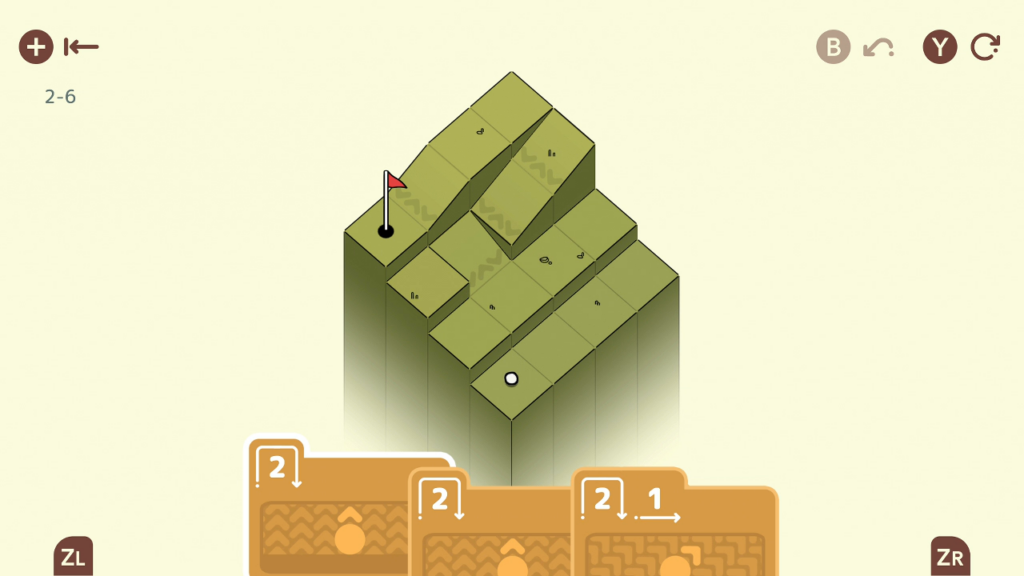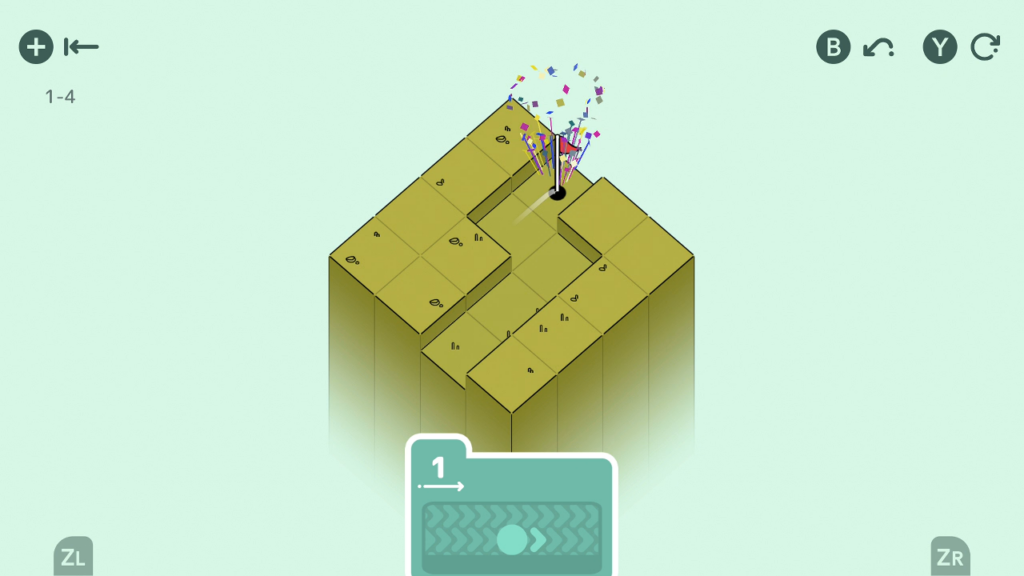Golf Peaks is a puzzle videogame that reimagines the game of golf into one of precise numbers on treacherous and impossible courses. Instead of hitting a ball with carefully timed swings from a digital golf club, I compel the ball to move along a three-dimensional grid using cards. Each card is prescribed with symbols and numbers that determine how the ball moves and how far it travels. In order to solve a puzzle, I must find the correct order to play its unique combination of cards that will deliver the ball to the hole. Golf Peaks offers more than 120 iterations of this puzzle with increasingly complicated courses and card combinations.

Traditional golf has a familiar ruleset. Using a variety of clubs made from differently weighted materials, a player hits a tiny ball into a hole across a course hundreds of yards long. The fewer strokes from their clubs they take to accomplish this task, the better their score.
Golf Peaks eschews most of these concepts. There are no individuated clubs to choose from. Courses are small, as though they encompass only the putting greens where golf’s short game happens. It’s possible puzzles are meant to represent miniature golf courses, but they have none of the visual markers of these kitsch family classics. Courses feel naturalistic even as they are divided into cubes and burdened with contraptions. The most radical departure from the rules of golf is scoring. My goal in any puzzle is to get the ball into the hole. I am not awarded differing point totals for better or worse performances. A win is a win.

When I consider these factors, I recognize that Golf Peaks barely qualifies as golf. The appellation becomes shorthand retaining only its most fundamental concept: Navigate a ball across obstacles and into a hole.
I direct a ball through a puzzle course by choosing the direction I want the ball to move, then selecting a card that governs how far and under what special conditions the ball will travel. A number shows how many grid squares the ball will travel, and a symbol determines if it rolls along the ground or in an arc through the air. The first few puzzles are straightforward, requiring no more from me than to move the ball in the right direction and the right number of spaces. The only stricture is precision. If the ball is two squares away from the hole, using a card that moves it three squares will send the ball rolling straight past my target. I have to apply the cards to the environment in such a way that the ball stops precisely on top of the hole.

After a few of these simple puzzles, complications begin to appear. The ball is compelled by gravity, so if it encounters a ramp it will roll down it, even beyond the distance stated by the card. Sand traps have the opposite effect; any ball entering a sand trap will be immobilized on its square, even if I use a card directing it to travel beyond the trap. Once a ball enters a sand trap, the only way to escape is with a card marked by an arcing arrow. On many puzzles, using ramps and sand traps to manipulate the ball’s path and get more or less distance from the available cards are key to reaching the hole.
Golf Peaks’ puzzles are divided into ten sections of twelve puzzles each, with each section adding a new complicating factor to the puzzles. Each section’s color palette suggests a passing through environments, though the visuals remain abstract enough that I cannot place any course in any specific place.

The earliest and simplest levels are colored a drab olive green, as though I am playing through a friendly and well-kept beginner’s range at a public course where the worst I have to worry about is a steep slope. The third section fills the puzzle space with arid brown colors, as though in a desert, and introduces the sand traps as well as mud pits which will swallow the ball if it comes to a stop on them. Later puzzles introduce colored tunnels that transport the ball to a paired tunnel elsewhere on the course, conveyor belts that carry the ball along winding paths, and fields of ice that slide the ball on endless, frictionless routes.
Though the courses introduce new tricks with every new batch, card functions remain simple. Moving the ball never grows more complicated than traveling flat along the ground or arcing through the air. The biggest complication introduced are cards which first move the ball in an arc for a few squares, and then flat along the ground for a few more.

Golf Peaks uses the simplicity of its cards to unleash some of its cleverest tricks. Early puzzles teach me to expect that I will use every card I am given to reach the hole. Tricky later puzzles may place red herrings in my hand, extra cards that are not needed to reach the hole. They exist only to mislead me about how close I am to solving the puzzle.
More devious still, some cards that move the ball both in an arc and along the ground can be effectively cut in half. If a ball lands from its arc directly onto the hole, the remaining flat movement will be ignored. In golf terms, this is like chipping an approach shot. This is an especially mean trick because it defies one of the first rules I am taught: That using more numbers than there are squares between ball and hole will always make the ball overshoot its target.
Solving a puzzle requires a lot of trial and error. I am allowed two ways to control my progress: A simple undo which returns the last used card to my hand and the ball to its previous position, and a total puzzle reset.

The undo is the most useful tool as it allows me to experiment. Sometimes it’s advantageous to work backwards through a puzzle, to look at where the hole is located, deduce which of my cards is most likely to reach that point, and find a way to move the ball to where that card may be used last. At other times it’s more helpful to work the ball towards the hole one step at a time, always taking the move that feels most advantageous, hoping to succeed on sheer intuition. At other times, a brute force method is applicable, trying every possible movement from every available card to see what unexpected results may happen. The speed and ease of the undo button makes all of these approaches viable with a minimum amount of friction and annoyance. I am never left fumbling with a confusing interface, letting me put all my energy into solving the current puzzle.
There isn’t much more to Golf Peaks than how it initially presents itself. It is a puzzle videogame that borrows some of the concepts of golf to make itself easily understood. There is no story to follow. There is not even the most abstruse of images to accompany its concepts. My satisfaction from progressing through its puzzles is derived from that alone. There is no statement to be made here, no broader question being asked, no point being made. It is a puzzle videogame and no more. This makes it universally accessible, but I worry it may also make it universally dull. From its start, I am engaged by one hundred and twenty puzzles for about five hours total. If I were not engaged, there is nothing here to draw me in or keep me playing.

Golf Peaks is a smart but featureless puzzle videogame. Its use of golf rules quickly falls apart when I really examine what is happening within its design. That design is nevertheless well thought out, with a gently growing complexity that keeps me challenged and engaged without becoming so inscrutable that I am sent in despair to answers on the internet or to another, less aggravating videogame. I predict its biggest obstacle will be in broad appeal. If its puzzles are not immediately satisfying to a player, then it will offer nothing to win them over. Despite its shortcomings, Golf Peaks is an adequate way to exercise my intellect for an evening.